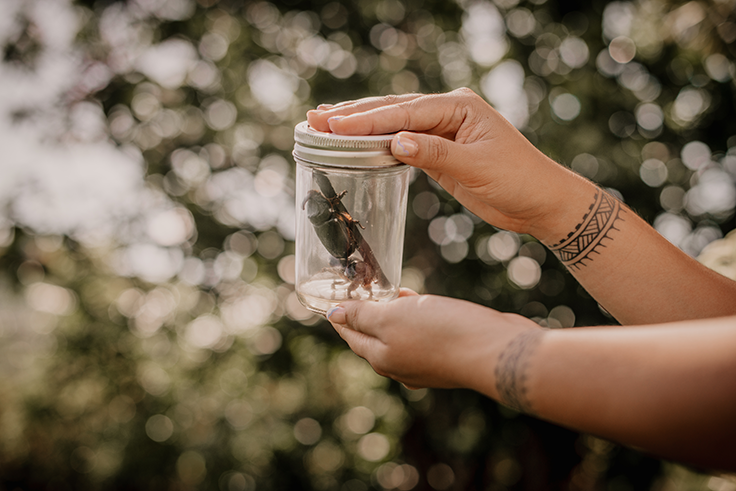A Niu Invasive in Town
September 13, 2024 – Haylin Chock


Kaua’i Invasive Species Committee (KISC) works across Kaua’i to prevent, control, or eliminate the most threatening invasive plant and animal species in order to preserve Kauaʻi’s native biodiversity and minimize adverse ecological, agricultural, economical, and cultural impacts.
In May 2023, two Coconut Rhinoceros Beetles (CRB) were trapped on Kaua’i near the Līhuʻe Airport and around the Līhuʻe Transfer Station. KISC found both beetles during routine monitoring of CRB traps placed for early detection around ports of entry as part of the Mamalu Poepoe program. This was the first detection of CRB on Kaua’i.

CRB is an invasive pest originally native to Southeast Asia. It attacks coconut palms by boring into the crowns or tops of the tree where it damages growing tissue. The damage can significantly reduce coconut production and, even, kill the tree. If its preferred food sources are unavailable, the beetle can shift to feed on other palms and tropical crops. This species had been previously contained to Oahu for the last ten years since the first detection in December 2013. The efforts to try and contain the species in Oahu has been a daunting task. Much of the efforts toward research and education has been spearheaded by the Coconut Rhinoceros Beetle Response team. Thanks to their efforts we at KISC and the other islands that have been impacted, have been able to get expert advice about containment. Rapid response teams from the University of Hawaiʻi – CRB Response Team, KISC, HDOA, and other partners have been surveying for possible breeding sites and suspect CRB palm damage island-wide. Additional monitoring traps have also been placed at high-risk sites across the island.Two small CRB breeding sites have been confirmed. Early detection and rapid management response are essential to safeguard Kaua’i from long-term CRB impacts.
CRB is a huge threat to not only Coconuts, but also a threat to cultural arts. CRB has been seen to attack Loulu and Hala trees. Although three plants seems like a short list of plants for this beetle to attack, it also means it can limit artists and cultural practitioners' supplies to continue crafting.
NIU: Coconut trees are known as a tree of 100 uses. Without coconut trees we won't have Apu for awa ceremonies, pahu drums, traditional cordiage, weaving, food supplies, and so much more. Kauaʻi is home to historical niu groves planted by our aliʻi. They are sentinels that mark an impact made in Kauaʻi history.

|
 |
 |

HALA: The hala tree is cultivated for things like lei. Lei hala is spiritually significant for cultural practitioners and lei makers. The leaves are used for traditional weaving, Ulana lauhala which has had a resurgence of popularity in recent years. Different varieties of hala produce different colorations in weaving products. If hala is wiped out, weavers will have to import materials from other countries, subsequently severing their connection with the care and cultivation of the plant.
LOULU: Loulu are native fan palms. Kauaʻi is the home of some varieties that are only found here and Niʻihau. Loulu are key to traditional hale thatching. Thanks to conservation efforts there has been cultivation of these plants but they are still not abundant in the wild. If CRB are able to feed on loulu, these trees are likely to be much less resilient that coconut trees and have been seen to die much faster after being attacked.
Identification:
CRB are quite large, measuring one-and-a-half to two inches in length. Their bodies are shiny dark brown or black and as their name implies, coconut rhinoceros beetles have horns on their heads. The CRB larva, or grub, also quite large, is light colored and can grow up to four inches.
 |
 |
 |
How to spot CRB Damage:
- Regular visual inspections of coconut trees are recommended. Watch for large V-shaped cuts in the crown of your palm trees or look for large bore holes at the base of palm fronds.
- Sift through compost regularly and look for large white grubs. CRB primarily breed their larvae in warm, dark, moist environments like mulch, compost, green waste, and soil piles.
|
|
AFTER |
Call to action
Early detection of infestations increases the chance of eradicating this pest on Kaua’i.
- Please regularly check your coconut, royal, and fan palms for CRB damage; and all compost bins and green waste for CRB larvae.
- Collect and submit questionable Larvae you find in mulch piles
- Refrain from moving and stockpiling CRB breeding materials.
- See something, say something. Report suspected trees to Kauai Invasive species Committee at KISC@hawaii.edu
The foreseeable impacts of CRB, if left unreported, are much larger than the loss of Coconut trees. CRB, despite the name, is known to attach Hala, Kalo, Sugar Cane, Native Loulu, and Bananas.
We implore our community to take the threat of CRB seriously as this single pest can potentially destroy Agriculture, Cultural practices and our native ecosystems.

|
 |
 |

|
 |
 |

 BEFORE
BEFORE
0 comments